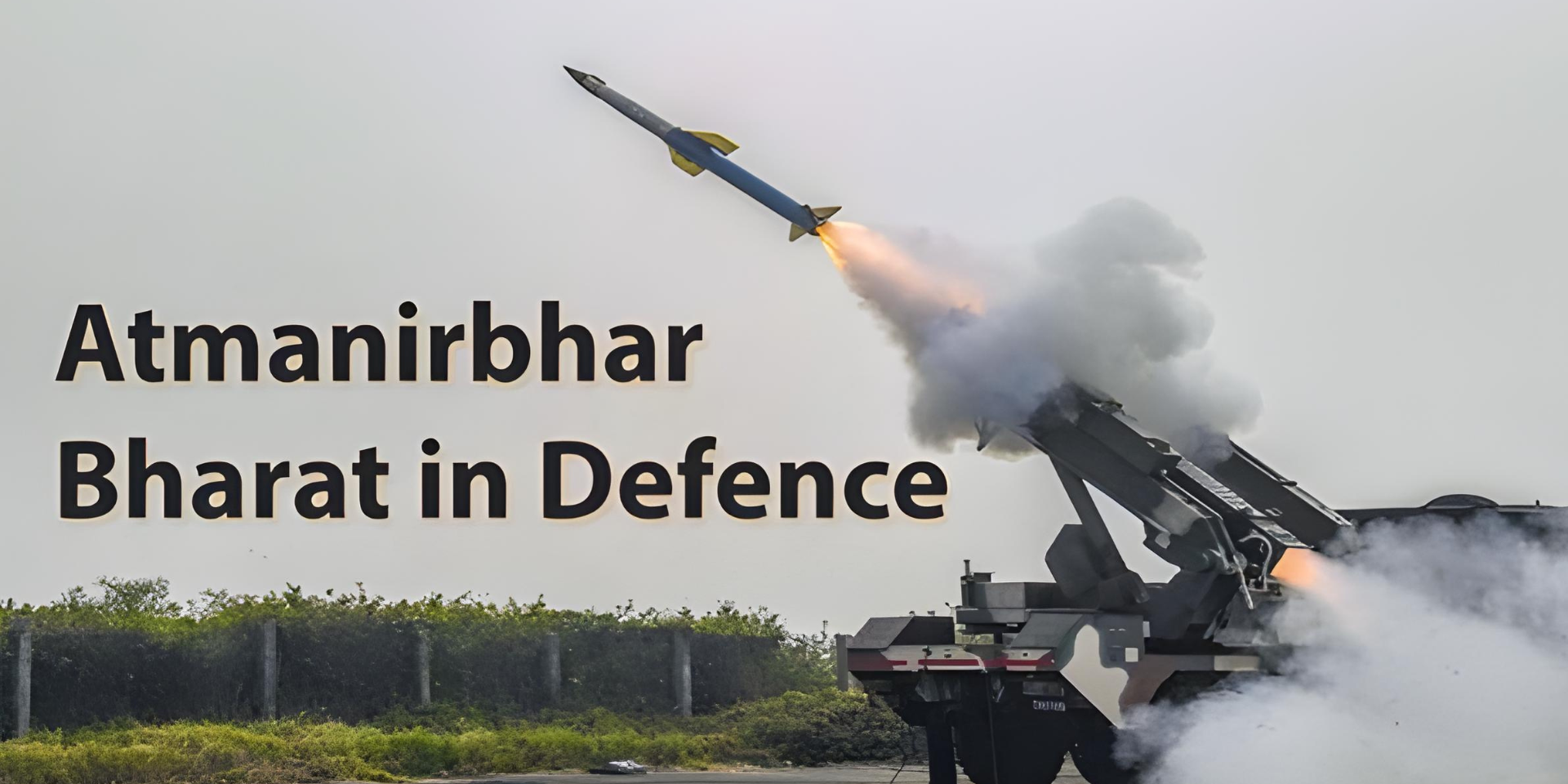
Swadeshi Defence Technologies of BHARAT: A Way Forward
With ambitious new projects including the Advanced Medium Combat Aircraft stealth fighter and hypersonic missiles nearing completion, India stands poised to emerge as a global leader in defence technology. — Dr. Dhanpat Ram Agarwal & Dr. LN Raghavendra
Introduction
The landscape of modern warfare is undergoing an intense transformation. Where once the strength of a nation’s military was measured by the sheer number of soldiers or the size of its arsenal, today’s battles are increasingly defined by technological superiority, precision weaponry, and rapid innovation. The emergence of high-tech systems ranging from stealth aircraft to precision-guided missiles has rendered traditional metrics of military might less relevant. In this new era, it is not the largest armies that prevail, but those equipped with the most advanced and agile technologies.
India has embraced this paradigm shift with remarkable resolve. Through the Swadeshi movement, championed by the Make in India and Atma-Nirbhar Bharat initiatives, the nation is not only reducing its reliance on foreign imports but is also nurturing a robust ecosystem of indigenous research, development, and manufacturing. The result is a new generation of world-class platforms such as the new generation Tejas fighter, BrahMos Supersonic cruise missile, and INS Vikrant aircraft carrier that reflect India’s growing prowess in defence technology. It has been amply demonstrated in “Operation Sindoor” that many indigenous technologies including Akash missiles have been deployed to achieve intended goals.
This commitment to self-reliance is a testament to the ingenuity and vision of Indian scientists, engineers, and industry leaders. By investing in home grown innovation and fostering a culture of excellence, India is forging a path toward true strategic autonomy ensuring that the nation’s security and sovereignty are best protected by the Bharat itself.
However, the global security environment has witnessed unprecedented changes, with defence expenditures reaching remarkable heights that reflect the intensifying nature of contemporary geopolitical challenges. According to the International Institute of Strategic Studies (IISS), global defence spending reached $2.46 trillion in 2024, marking a substantial increase from $2.24 trillion in the previous year. This represents an average of 1.9 percent of the world’s GDP, reflecting heightened security challenges across multiple regions.
The surge in military spending has been primarily driven by deteriorating security environments and sharpened threat perceptions in regions such as Europe, the Middle East and North Africa (MENA), and Asia. The ongoing Russia-Ukraine conflict, the ongoing Israel-Iran-Lebanon-Palestine conflict, tension in the South China Sea and various regional disputes have compelled nations to reassess their defence priorities and allocate increased resources to military capabilities, with the Top 10 countries accounting for 73 percent of worldwide military expenditure.
Indian Defence Capabilities: A Swadeshi Renaissance
India’s trust with indigenous defence capability began soon after independence. Recognizing the strategic vulnerabilities of relying on imported critical defence systems, India gradually built its own institutions and industrial base. In the 1950s and 1960s, the country established the Defence Research and Development Organisation (DRDO) and started indigenous production of basic arms and ammunition. In 1974, India’s first nuclear test at Pokhran, codenamed Smiling Buddha, was a testament to its scientific capability and determination for self-reliance. The 1980s and 1990s saw the emergence of indigenous programs such as the Light Combat Aircraft (LCA) Tejas, the Arjun Main Battle Tank, and the Prithvi missile program. In 1998, Operation Shakti—a series of nuclear tests—reaffirmed India’s position as a self-reliant nuclear power. Over these decades, restrictive international regimes like the MTCR, NSG, and Wassenaar Arrangement forced India to innovate under constraints, laying a resilient foundation for its modern Swadeshi defence ecosystem.
India’s journey toward self-reliance in defense began with the Integrated Guided Missile Development Program (IGMDP) in 1984, led by Dr. Abdul Kalam. This program developed several key missile systems including Agni, Prithvi, Akash, Nag, and Trishul. Today, all except Trishul have been successfully inducted into the Armed Forces.
The Agni missile series, with ranges up to 5,000 kilometers, and Prithvi missiles, with ranges up to 500 kilometers, form India’s ballistic missile arsenal. These precision-guided systems can accurately strike intended targets. The Akash surface-to-air missile and Nag anti-tank missile complete this diverse missile portfolio. Through the IGMDP, India developed crucial technologies in structures, propulsion, guidance systems, navigation, and warhead design. Building on this foundation, India has also produced newer systems like the Quick Reaction Surface to Air Missile (QRSAM) and Medium Range Surface to Air Missile (MRSAM).
The success of India’s missile program stems from early partnerships with development partners. Public sector companies like Bharat Dynamics Limited (BDL), Hindustan Aeronautics Limited (HAL), and Bharat Electronics Limited (BEL) have played crucial roles. Equally important has been the integration of private sector companies such as L&T, Godrej and Boyce, and Tata Advanced System Limited into both development and manufacturing processes. India has also embraced international collaboration, as seen in joint projects like the BrahMos missile with Russia and MRSAM with Israel, showing how India has evolved from purely local development to strategic partnerships that integrate global knowledge and design expertise.
These collaborative efforts have produced remarkable results. India’s defense production reached a record Rs. 1.27 lakh crore (approximately $15.3 billion) in 2023-24, marking a significant milestone in the nation’s journey toward self-reliance. What makes this achievement even more impressive is that over 70% of these contracts went to Indian companies, demonstrating the growing capability of domestic defense manufacturers.
The export success is equally noteworthy, with defense exports reaching Rs. 21,083 crores ($2.5 billion)—a nearly 20-fold increase over the past decade. This growth reflects global recognition of Indian defense platforms, with indigenous systems like Tejas, BrahMos, and Pinaka generating significant international interest and establishing India as a respected player in the global defense market.
Indian Air Force: Indigenous Wings of Power
The transformation of India’s aerial warfare capabilities represents one of the most significant achievements of the Swadeshi movement. At the forefront of this revolution stands the Tejas, the Light Combat Aircraft (LCA), a 4.5-generation multi-role fighter that serves as a powerful symbol of Indian engineering excellence. This sophisticated aircraft incorporates cutting-edge technology including a glass cockpit, fly-by-wire controls, precision targeting systems, and beyond visual range missile capability, placing it in the same league as globally renowned fighters like the F-16 and JAS 39 Gripen. The Indian Air Force has already inducted over 40 jets into service, with an additional 83 Mk-1A variants on order, while export interest continues to grow from countries including Malaysia, Argentina, and Egypt.
India’s foray into unmanned combat aerial vehicles represents another leap forward in indigenous defence technology. The nation’s stealth UCAV, designed for autonomous deep-strike missions, features an advanced flying wing design integrated with sophisticated stealth capabilities and artificial intelligence systems. This platform positions India among the select few nations capable of developing and deploying such advanced unmanned systems.
The indigenous missile systems powering India’s airforce demonstrate remarkable technological sophistication. The Astra Mk-1 and Mk-2 beyond visual range missiles, with ranges extending up to 160 kilometers, are comparable to premier international systems such as the US AMRAAM and European Meteor missiles. These weapons provide Indian pilots with world-class air-to-air combat capabilities, ensuring air superiority in any potential conflict scenario.
Enhancing the operational effectiveness of these platforms is the Netra, the Airborne Early Warning and Control System (AEW&CS), mounted on Embraer aircraft platforms. This sophisticated system provides comprehensive 360 Degree radar coverage, significantly enhancing command and control capabilities and providing Indian forces with superior situational awareness across the battlefield.
Indian Army: Swadeshi Strength on Land
The Indian Army’s transformation through indigenous technology spans multiple domains, from advanced missile systems to cutting-edge combat vehicles. The Akash Surface-to-Air Missile system exemplifies this technological revolution, serving as a mobile, all-weather, medium-range surface-to-air missile system with an operational range of 25-40 kilometres. This system, developed by the Defence Research and Development Organisation with significant contributions from the Defence Research and Development Laboratory (DRDL) and Research Centre Imarat (RCI), is comparable to established international systems like the Russian Buk and Israeli Spyder. The Indian armed forces have deployed over 12 regiments of this system, providing comprehensive air defense coverage across critical installations and formations.
Complementing the Akash system is the Quick Reaction Surface to Air Missile, an indigenous mobile quick-reaction surface-to-air missile system designed specifically to protect moving army formations from aerial threats. With a range of 25-40 kilometers, this system features dual AESA radars and possesses the capability to simultaneously engage multiple targets with exceptional accuracy. The Medium Range Surface to Air Missile system, jointly developed by DRDO and Israel, extends this protective umbrella even further, capable of neutralizing aerial threats up to 70 kilometers away using advanced radar and active seeker technology. This system has been deployed across all three branches of the Indian armed forces, developed by DRDO’s Armament Research and Development Establishment, which specializes in advanced armament systems.
Artillery capabilities have been revolutionized through the indigenous Pinaka Multi-Barrel Rocket Launcher system, which has evolved from its original design to incorporate precision-guided variants for enhanced accuracy with a range extending from 45 to 75 kilometers, this system provides Indian forces with devastating long-range firepower capabilities. The confidence in this system is reflected in substantial orders worth Rs. 2,580 crore placed in 2023, developed by ARDE Pune, renowned for its artillery and rocket systems expertise.
Combat vehicle capabilities have reached new heights with the Arjun Mk-1A Main Battle Tank, an advanced platform featuring composite armour, a powerful 120mm rifled gun, missile-firing capability, and state-of-the-art fire control systems. With over 120 Arjun tanks already inducted and 118 Mk-1A variants on order, this platform is considered comparable to top global tanks including the Leopard 2 and M1 Abrams. Developed by the Combat Vehicles Research and Development Establishment (CVRDE), this tank represents the pinnacle of Indian armoured vehicle technology.
The integration of these platforms is enhanced by fully indigenous tactical communication and battlefield management systems that enable secure, real-time communication and data sharing across the entire battlefield. These systems significantly enhance situational awareness and command efficiency for Indian forces, providing a technological edge that translates directly into operational superiority.
Indian Navy: Indigenous Power at Sea
India’s naval capabilities have been transformed through ambitious indigenous shipbuilding and technology programs that position the nation among the world’s premier maritime powers. The crown jewel of this transformation is INS Vikrant, India’s first indigenous aircraft carrier with a displacement of 45,000 tons. This magnificent vessel, commissioned in 2022, operates MiG-29K fighters and naval helicopters, joining India to an elite group of nations possessing such advanced carrier capability. The successful development and deployment of this platform demonstrates India’s mastery of complex naval engineering and systems integration.
Submarine capabilities have been substantially enhanced through the Kalvari-Class submarines, built under the Make in India initiative by Mazagon Dock Limited. These submarines are equipped with advanced sonar systems and are ready for Air Independent Propulsion upgrades, significantly extending their underwater endurance. With six submarines planned and five inducted by 2024, this program represents a major milestone in India’s submarine manufacturing capabilities.
The strategic deterrence capabilities of the Indian Navy have been revolutionized through the INS Arihant-Class nuclear-powered ballistic missile submarines, which are entirely indigenous in design and construction. These submarines are capable of launching K-15 missiles with a range of 750 kilometres and K-4 missiles with a range of 3,500 kilometers, providing India with a credible sea-based nuclear deterrent.
Advanced underwater warfare capabilities have been developed through DRDO’s Supersonic Missile Assisted Release of Torpedo system, designed for long-range anti-submarine warfare operations. The Naval Materials Research Laboratory under DRDO has developed indigenous hydrogen fuel cell-based Air Independent Propulsion technology for submarines, extending the underwater endurance of diesel-electric submarines like the Kalvari class. This breakthrough technology enables submarines to operate silently while submerged for extended periods, significantly enhancing stealth and operational effectiveness for the Indian Navy.
Sonar systems development has been spearheaded by the Naval Physical and Oceanographic Laboratory under DRDO, which has developed indigenous sonar systems for Indian Naval ships & submarines. These sophisticated systems provide comprehensive underwater threat detection, tracking, and anti-submarine warfare capabilities across multiple naval platforms.
International Collaborations – A requirement for the future development
The BrahMos supersonic cruise missile, developed jointly by India and Russia, is a major advancement for India’s armed forces. Capable of being launched from land, sea, air, and submarines, it travels at speeds up to Mach 3 and currently has a range of 350-400 kilometers, with future versions aiming for 800 kilometers. Its two-stage design, “fire-and-forget” accuracy, and stealth features make it one of the world’s most effective cruise missiles. Alongside this, India’s air defence has been boosted by the AkashTeer system, an indigenous short-range missile integrated with the Russian S-400 system. Designed for quick response and high mobility, AkashTeer can intercept aircraft, drones, and missiles within a 25-40 kilometer range, providing strong protection for key installations. Ongoing international collaborations aim to further enhance these systems’ capabilities.
Global Defence Spending – A wakeup Call for Swadeshi Development
The world’s largest military spender in 2025, the United States, not only continues to dominate the rankings but also makes up 62.3% of the global top 5 military spenders. The United States maintains its position as the world’s largest military spender, allocating $997 billion, which accounts for 37% of global military expenditure. China follows as the second-largest spender with $314 billion, representing approximately 12% of global military spending. Together, these two nations dominate global defence spending, reinforcing their status as the world’s leading military powers.
India’s position as the fifth-largest military spender globally, with expenditure of $86.1 billion, demonstrates the nation’s commitment to regional security and defence modernization. This spending represents 2.3% of India’s GDP and 3.2% of global military expenditure, highlighting the country’s growing strategic importance. Therefore, the necessity of increasing the indigenisation effort for the long term development while adopting collaborative effort in short and mid-term is absolutely essential.
Indigenous platforms now form the backbone of India’s strategic deterrence and operational readiness, ensuring that the nation’s security infrastructure is built upon reliable, domestically controlled technology. The success of these programs has positioned India among the world’s top 25 defence exporters, transforming the nation from a major importer to a significant player in the global defence market.
In the context of global military spending trends, India’s position as the fifth-largest military spender with $86.1 billion in defence expenditure reflects the nation’s commitment to maintaining robust defence capabilities while pursuing indigenous development. This investment strategy not only enhances national security but also contributes to technological advancement and economic growth through the development of domestic defence industries.
The transformation of India’s defence landscape through the Swadeshi movement has yielded remarkable results that extend far beyond military capabilities. India has successfully reduced its defence imports from 70% to below 50% over the past decade, demonstrating the effectiveness of indigenous development programs. This shift has created over 2 million jobs in the defence sector, contributing significantly to economic growth and skill development across the nation. However, it can be seen from a table below, the distribution of global military spending which reveals the dominance of major powers.
Top 10 Countries with Highest Military Spending in 2025
Rank Country Military Spending (2024) Share of Global Total
1 United States $997B 36.7%
2 China $314B 11.6%
3 Russia $149B 5.5%
4 Germany $88.5B 3.3%
5 India $86.1B 3.2%
6 United Kingdom $81.8B 3.0%
7 Saudi Arabia $80.3B 3.0%
8 Ukraine $64.7B 2.4%
9 France $64.7B 2.4%
10 Japan $55.3B 2.0%
Government Initiatives and Industry Ambitions
Larsen & Toubro (L&T) is aiming to create a multi-billion dollar defence business, marking a sharp rise from Rs. 6,185 crore (about $726 million) of orders in the previous fiscal year, encouraged by the government’s strong push to upgrade and modernise the military. The engineering conglomerate has established a broad presence in the defence sector, manufacturing warships, patrol vessels, armoured vehicles, artillery guns, and missile systems, among others. The Narendra Modi government has set an ambitious target of Rs. 30,000 crore worth of defence exports this fiscal year, with the goal of reaching Rs. 50,000 crore by FY29. The government is also aiming for domestic defence production of Rs. 1.6 lakh crore in FY26, and nearly doubling that to Rs. 3 lakh crore by FY29.
Conclusion
India’s Swadeshi movement in defence represents far more than a policy initiative; it embodies a national renaissance that demonstrates the power of indigenous innovation and strategic vision. By harnessing the exceptional talent of Indian scientists, engineers, and industries, India is constructing a secure, self-reliant future that serves as an inspiration to developing nations worldwide. The remarkable journey from import dependence to indigenous innovation tells a compelling story of vision, resilience, and unwavering patriotism. Within the global context of rising defence expenditures, where military spending has reached unprecedented levels of $2.46 trillion in 2024, India’s approach of combining strategic defence investment with indigenous capability development stands as a model for sustainable security enhancement. While the United States continues to dominate global military spending, accounting for 62.3% of the top five spenders, India’s focused investment in indigenous technologies demonstrates that effective defence capabilities can be achieved through strategic innovation rather than merely increased spending.
With ambitious new projects including the Advanced Medium Combat Aircraft stealth fighter and hypersonic missiles nearing completion, India stands poised to emerge as a global leader in defence technology. This transformation continues to inspire the world with the authentic spirit of Swadeshi, proving that a nation’s commitment to self-reliance, combined with scientific excellence and industrial capability, can achieve extraordinary results that secure both present prosperity and future sovereignty.
Dr. Dhanpant Ram Agarwal, National Co-convenor, SJM. and
Dr. LN Raghavendra, Outstanding Scientist Director (Propulsion), Centre for Military Airworthiness and Certification. DRDO, Ministry of Defence, GOI


